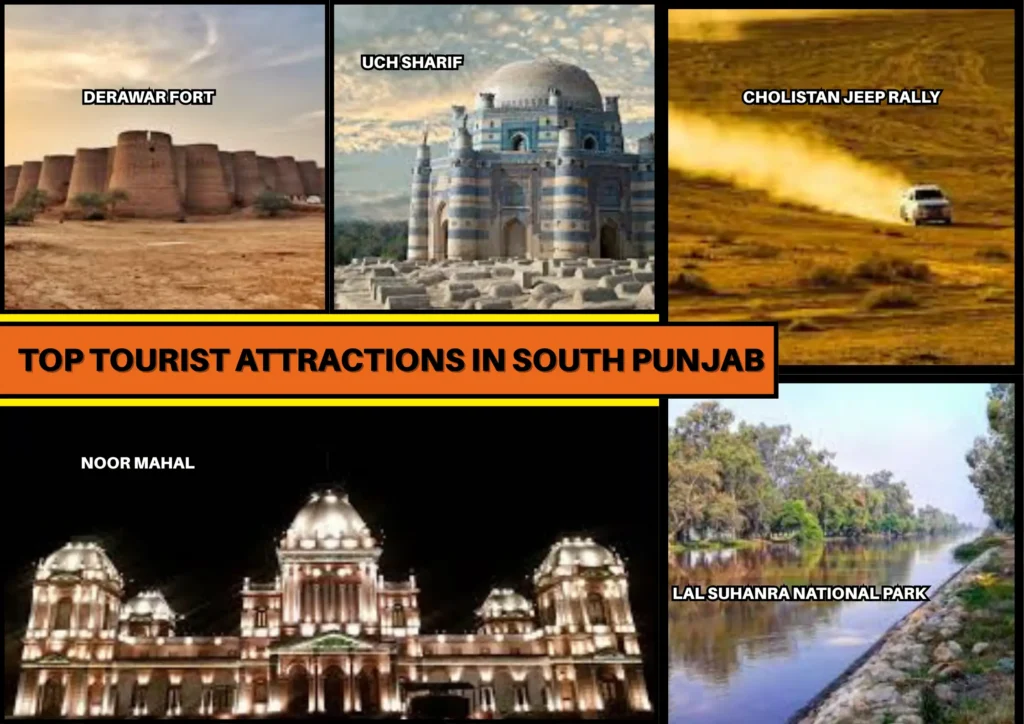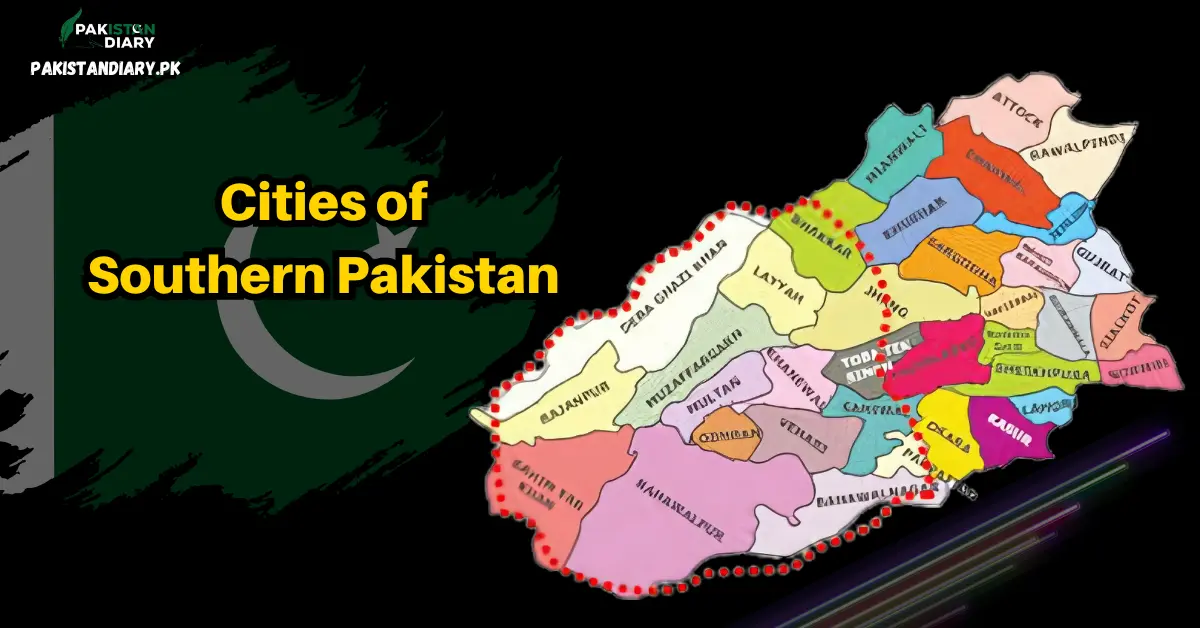South Punjab feels like a quiet heartbeat in the larger body of Pakistan, overshadowed by the center of Punjab, but it’s far from forgettable. From the sands of Cholistan to the green fields of Rahim Yar Khan, this southern stretch of Pakistan carries a deep, steady rhythm. It speaks in Saraiki, sings through Sufi poetry, and holds centuries of history in its shrines and forts. More than just tradition, South Punjab is now stepping into the spotlight with new roads, economic zones, and development plans. It’s a region rooted in the soul, and ready for transformation.
List of Major Cities in South Punjab
South Punjab is a culturally rich and historically significant region located in the southern part of Punjab province. It includes several important cities known for agriculture, trade, Sufi heritage, and diverse languages like Saraiki.
- Multan
- Bahawalpur
- Dera Ghazi Khan
- Muzaffargarh
- Rajanpur
- Rahim Yar Khan
- Layyah
- Lodhran
- Vehari
- Khanewal
- Mian Channu
- Kot Addu
- Chowk Azam
- Jampur
- Alipur
- Sadiqabad
Administrative Division of South Punjab Cities
South Punjab is made up of several districts grouped under three main administrative divisions. Each division includes important cities known for their cultural, historical, and economic significance.
| Division | District | Major City |
| Multan Division | Multan Khanewal Vehari Lodhran | Multan Khanewal, Mian Chnnu Vehari Lodhran |
| Bahawalpur Division | Bahawalpur Bahawalnagar Rahim Yar Khan | Bahawalpur Bahawalnagar Rahim Yar Khan, Sadiq Abbad |
| G. Khan Division | Dera Ghazi Khan Layyah Muzaffargarh Rajanpur | Dera Ghazi Khan Layyah, Chowk Azam Muzaffargarh, Kot Addu, Ali Pur Rajanpur, Jampur |
Multan
Multan is known as the City of Saints—and that’s not just a nickname. It’s where Sufi mystics like Bahauddin Zakariya and Shah Rukn-e-Alam built centers of learning and spirituality. The Multan Fort still towers over the old city, surrounded by grand gates like Lohari and Bohar. Beyond its heritage, Multan is also a modern trade center with motorways, an international airport, and industrial estates. In 2020–21, Multan exported approximately 155,862 tonnes of fresh mangoes (valued at Rs 22.59 billion), according to the Department of Horticulture, Multan.
Bahawalpur
Bahawalpur offers something few Pakistani cities can—royal legacy. Once ruled by the Nawabs, the city still glows with architectural gems like Noor Mahal, Sadiq Garh Palace, and the Abbasi Mosque. The adjacent Cholistan Desert is home to Derawar Fort, part of Pakistan’s UNESCO Tentative List since 2016. Bahawalpur is also known for Lal Suhanra National Park, one of the few places in Asia where desert, forest, and wetland ecosystems meet.
Dera Ghazi Khan
DG Khan stands where the plains meet the mountains. It has a strong tribal identity, with Baloch influence shaping language and traditions. In recent years, it has become a hub for public investment, Mir Chakar Khan Rind University of Technology was established through a provincial Punjab Assembly bill in 2019 , while Fort Munro Cadet College was launched in 2018 through a provincial agreement with the Pakistan Air Force. Roads, hospitals, and solar energy projects are bringing tangible improvements to this once-neglected frontier.
Muzaffargarh
Muzaffargarh is wrapped in rivers and crisscrossed by canals. It’s an agricultural powerhouse, producing mangoes, cotton, and sugarcane in bulk. The Punjab Irrigation Department lined 33 km of canals to reclaim 300,000 acres of waterlogged land, enhancing crop output and strengthening flood protection systems (Daily Times). Despite its rural setting, the district is catching up with new roads and energy infrastructure.
Rahim Yar Khan
Rahim Yar Khan, located near the Sindh border, is a multilingual melting pot. The Sheikh Zayed Hospital, a UAE-funded facility, now includes a nuclear medicine unit and heart surgery complex. The district has also received a 220 kV grid station, improving energy supply for homes and industries (Power Line). Its central location makes it a key transit and trading city.
Layyah, Rajanpur, Vehari, Lodhran, Khanewal, Bhakkar
- Layyah: A wheat and cotton-producing zone with ongoing road dualization projects, such as the Layyah–Chowk Azam road, improving intra-district connectivity.
- Rajanpur: Known for its rugged terrain and hill torrents; the district has received attention for flood relief efforts, though comprehensive protection projects remain in progress.
- Vehari: Home to over 100 cotton ginning factories and active grain markets, reinforcing its role in South Punjab’s agro-based economy.
- Lodhran: A strategic grain storage and transport junction with new warehousing schemes.
- Khanewal: A major rail junction city with an established agro-industrial base, including oil, ghee, and flour mills.
- Bhakkar: Predominantly agricultural, benefiting from the Greater Thal Canal Phase-I, which irrigates over 350,000 acres in Thal districts.

Top Tourist Attractions in South Punjab
- Derawar Fort: A 9th-century fort with 40 bastions, preserved under provincial and UNESCO frameworks.
- Uch Sharif: A mystical town with 12th-century Sufi tombs under active archaeological conservation.
- Noor Mahal: A grand palace in Bahawalpur open for public and cultural events.
- Lal Suhanra National Park: Covers 162,568 acres and includes a wildlife sanctuary (source – Punjab Forest Dept).
- Cholistan Jeep Rally: Hosted every spring with over 70,000 attendees and supported by TDCP .
Culture & Lifestyle
Life in South Punjab is rooted in Sufism, agriculture, and local crafts. Saraiki is the most spoken language, followed by Punjabi, Urdu, and pockets of Balochi. Cultural events like Urs of saints attract thousands. The bazaars sell Ajrak, Khaddar shawls, and Sohan Halwa. In recent years, the Punjab government has launched cultural revival programs to support local artisans and build heritage galleries in Multan and Bahawalpur.
Economy & Development
South Punjab drives Pakistan’s agricultural power, producing a significant share of cotton, wheat, rice, and mangoes. In mid-2024 alone, Pakistan exported 13,681 tonnes of mangoes, earning $46.7 million—largely sourced from Multan and Rahim Yar Khan (Express tribune). The South Punjab Secretariat, under construction in Multan and Bahawalpur, centralizes regional development efforts and funds (Associated Press of Pakistan). Major infrastructure projects are underway: canal embankments, roads, and grid stations, alongside CPEC Western Route links through Dera Ghazi Khan and Multan—laying groundwork for impactful economic zones. This blend of agriculture, governance, and connectivity positions South Punjab for steady growth.
Why South Punjab Matters
South Punjab isn’t just culturally rich, it’s politically and economically vital. It forms a strategic buffer between Punjab and Balochistan, sits along key CPEC corridors, and has a youthful population eager for jobs and education. New public universities, smart classrooms, rural hospitals, and energy infrastructure are being launched across the region.
FAQs About South Punjab Cities
- what are Major South punjab cities?
Multan, Bahawalpur, DG Khan, Muzaffargarh, Rahim Yar Khan. - Is South Punjab different from north Punjab?
Yes, it has a distinct language, culture, and governance focus. - Main language?
Mostly Saraiki; also Urdu, Punjabi, and Balochi. - Safe to visit?
Yes, roads and tourist spots are well-secured. - Most historical sites?
Derawar Fort, Uch Sharif, Noor Mahal, Multan Fort.
Final Thoughts
South Punjab is no longer a side note. With historical depth, cultural resilience, and real development gains, it’s becoming one of Pakistan’s most exciting regions. Whether you’re an academic, a traveler, or an investor, the cities of South Punjab invite exploration—offering meaning, history, and momentum.





